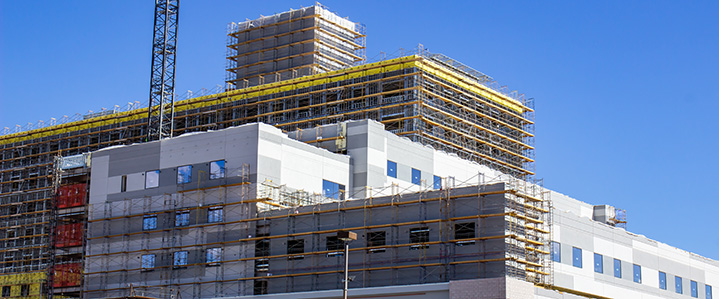Ventilation Tips to Reduce the Spread of COVID-19 in Long-Term Care Facilities during the Winter Holiday

For the second holiday season the US is experiencing an escalation in COVID-19 cases. This presents cause for concern for long-term care facilities that anticipate an increase in visitors during the holidays. On top of this, colder winter temperatures mean facilities may not have the option to open windows to improve ventilation or to hold gatherings outdoors. The good news is that there are actions long-term facilities can take to improve ventilation to help protect their residents, visitors and staff during the winter holidays.
To effectively mitigate spread of the virus a multi-layered approach is essential, and ventilation is a critical layer of protection. Here are some tips that facility managers of long-term care facilities can employ during the holidays to improve ventilation to reduce transmission of COVID-19.
Get the Right Stakeholders Engaged
The goal is to increase outdoor air or increase the amount of clean air delivery to a space without compromising system performance. Before making any system modifications it will be important to engage the right stakeholders to ensure efforts are successful. This may include:
- Tenants and managers
- Testing and balancing contractor
- Building controls contractor
- Mechanical contractor
- Building owner and/or operator
Upgrade HVAC Filtration
- Where possible, increase the level of filtration in air handling systems to a Minimum Efficiency Reporting Value (MERV)-13 or greater if existing air handling systems permit. An assessment of the current filtration coupled with air handling unit performance information can be used to determine whether the existing fan systems can overcome the additional pressure drop of the new filters while still maintaining appropriate air flow.
- If MERV-13 filters cannot be installed because of fan limitations or physical limitations, consider increasing the filtration in the air handling system to the maximum MERV rating available or possible.
Install Portable HEPA-Filtered Units
- Place portable high efficiency particulate air (HEPA)-filtered units in event spaces, especially those with little to no mechanical ventilation. Also consider adding HEPA-filtered units to areas without mechanical ventilation occupied by multiple residents, visitors and staff.
- Select a HEPA-filtered unit that has a clean air delivery rate certified according to the Association of Home Appliance Manufacturers (AHAM) or a similar rating agency.
- Visit the ASHRAE website for detailed technical information on selection of portable filtration units.
- Placement and quantity of the units depends on the individual room and the device specifications; refer to manufacturer instructions.
- AHAM provides a database of air cleaners that can be searched by room size.
Inspect and Maintain HVAC Systems
Inspect HVAC system components to verify proper function. Inspection should include the following elements:
- Fan belt(s) are appropriately tensioned to ensure full airflow is provided to space(s).
- Confirm outdoor air and other damper linkages are fully connected and operational.
- Ensure heating and cooling coil valves and valve actuators are connected and operational.
- Check for dirt/dust accumulation on air filters and replace filters as needed.
- Inspect HVAC system air filters and replace with new filters if deemed necessary.
- Inspect air filter installation and ensure filters are properly fitted and have little to no bypass around filter banks.
- For HVAC systems with heat recovery wheels, check to make sure there is no leakage and cross-contamination. Consider deactivating these wheels until a service technician checks the operation and condition.
- Confirm all building exhaust systems are operating properly.
Choose Mechanically Ventilated Spaces
- When planning for events and gatherings, prioritize the selection of spaces that offer mechanical ventilation over those with only natural ventilation or no ventilation, when possible.
- Occupancy of spaces should be limited based on supplied ventilation, setting, and room size. Ventilation of resident activity and dining spaces should meet a minimum of 4 air changes per hour of outdoor air. (ASHRAE Standard 170-2017 — Ventilation of Health Care Facilities, Table 7.1.)
Adjust Occupancy Schedules
- Special events may result in the occupancy of a space outside of typical operating hours. Modify building automation system (BAS) occupancy schedules as needed to fit event schedules. Start HVAC systems at least two hours before occupancy of event spaces and turn them off two hours after events end.
- Confirm occupancy schedules for HVAC systems and review timer set points and programmed operating schedules in the BAS. Modify the occupancy schedule as needed to fit the current occupancy schedules for the facility.
- Shared restroom exhaust systems are recommended to be operated continuously.
Facilities with No Mechanical Ventilation
- Ensure all windows are operable.
- Keep windows open as much as possible to promote increased ventilation. Open windows during periods of occupancy when the weather is good, or even just a few inches in cold weather.
- Operate all building exhaust fans continuously to help increase air turnover.
- Consider using portable HEPA-filtered air cleaners to increase air cleaning. It is important to choose a portable HEPA unit based on room size or CADR (clean air delivery rate); follow air exchange calculations.
These tips offer high-level guidance and are informed by heating, ventilating and air conditioning (HVAC) guidance from relevant authorities including the U.S. Centers for Disease Control and Prevention (CDC) and the American Society of Heating, Refrigerating and Air-Conditioning Engineers (ASHRAE). ASHRAE also provides detailed guidance specific to residential healthcare facilities.
Ventilation plays a critical role in preventing transmission of COVID-19 and should be part of a multi-layered approach to protect patients, residents, staff and visitors. For expert guidance on a multi-layered approach including ventilation strategies for your facility, contact us today.
Additional Resources
Subscribe
to our blog
"*" indicates required fields





